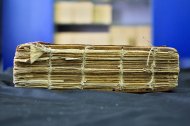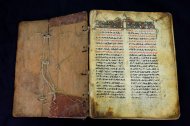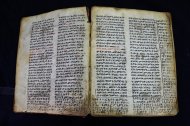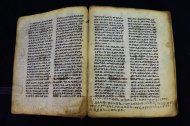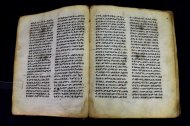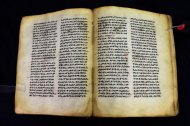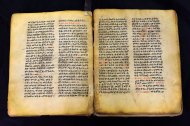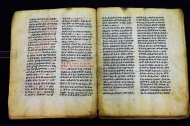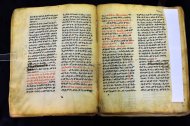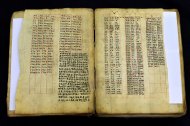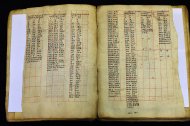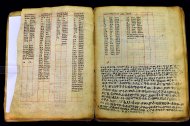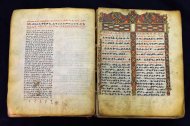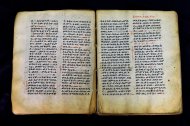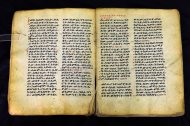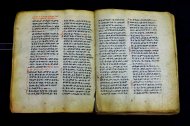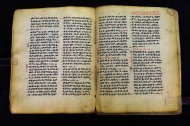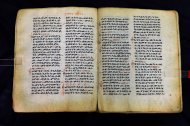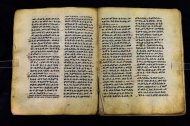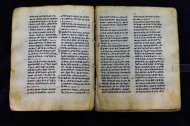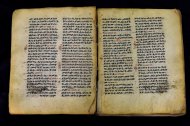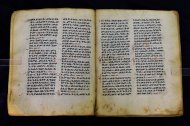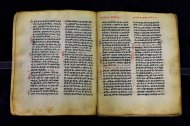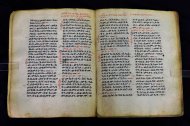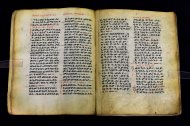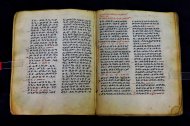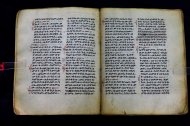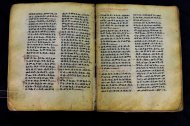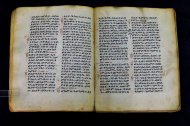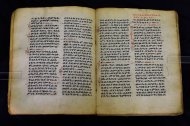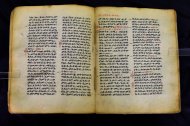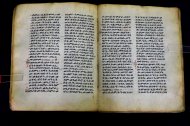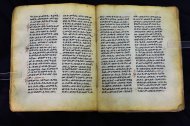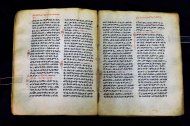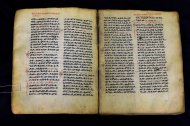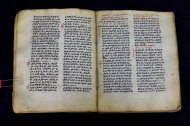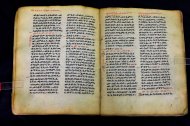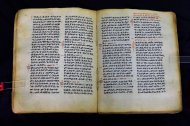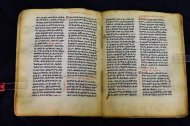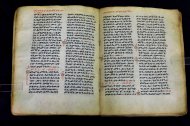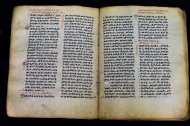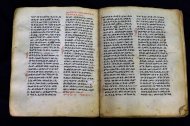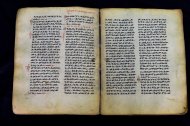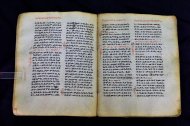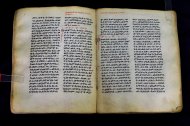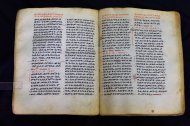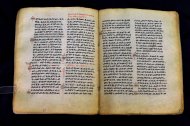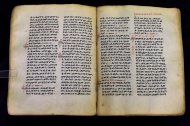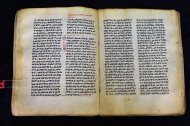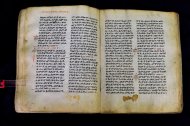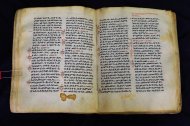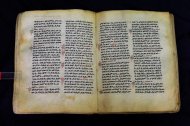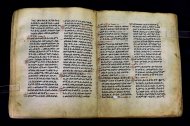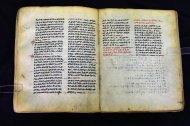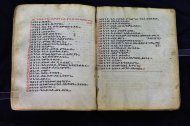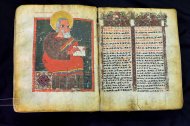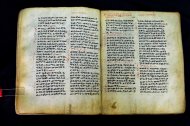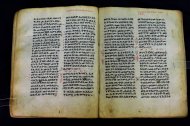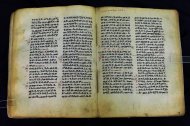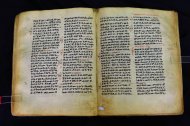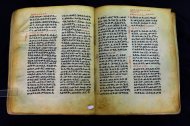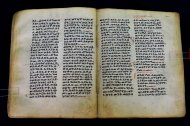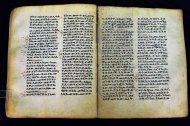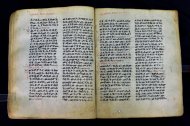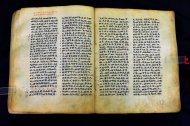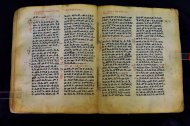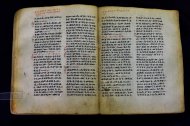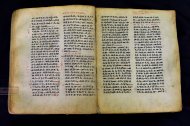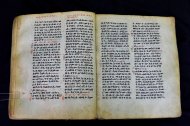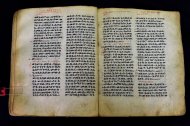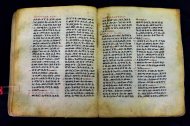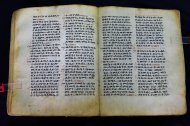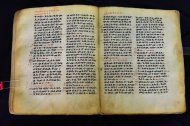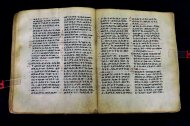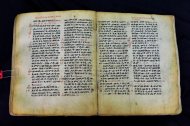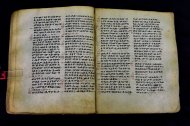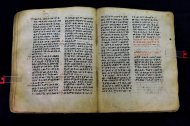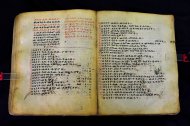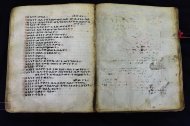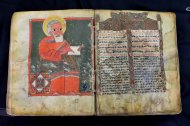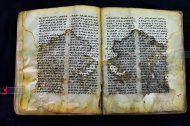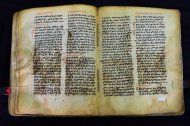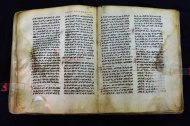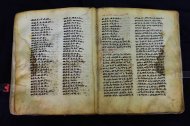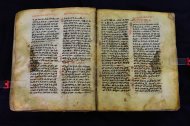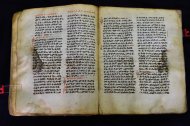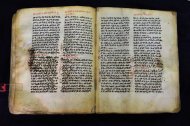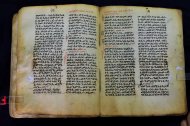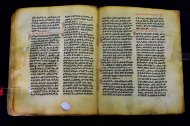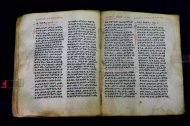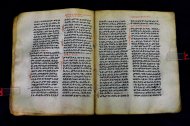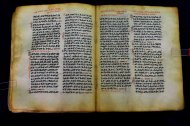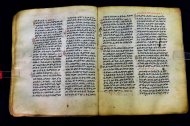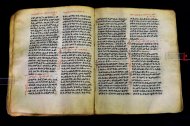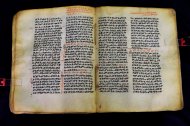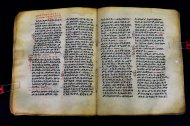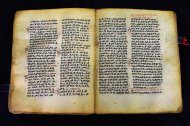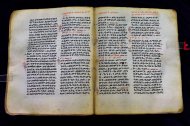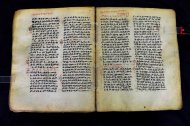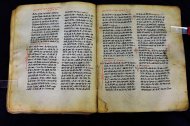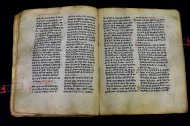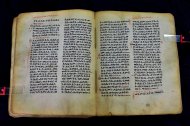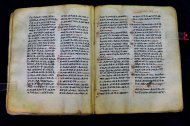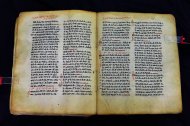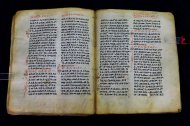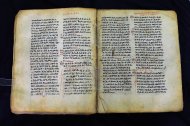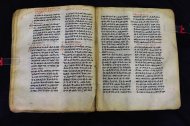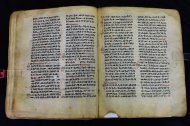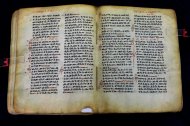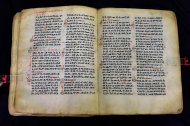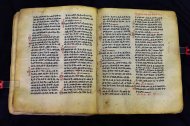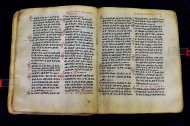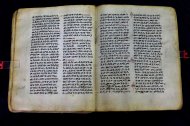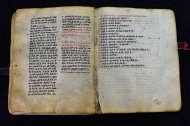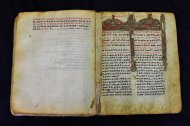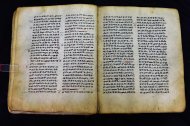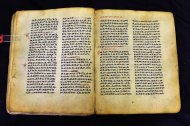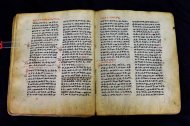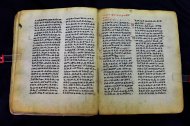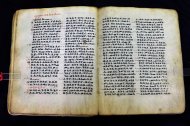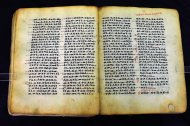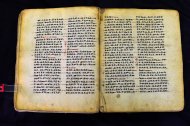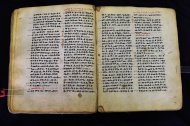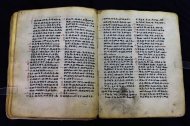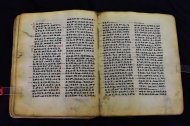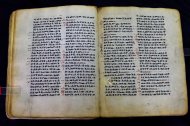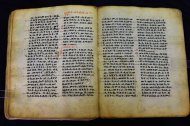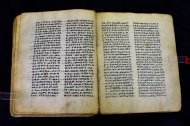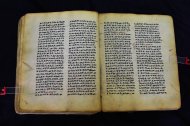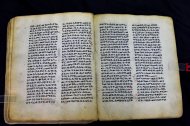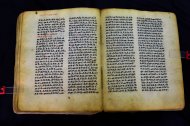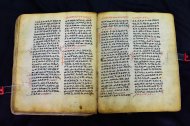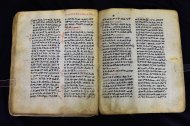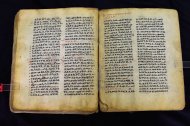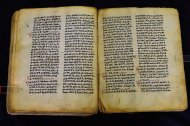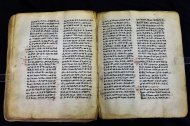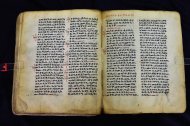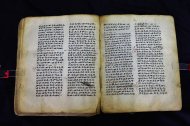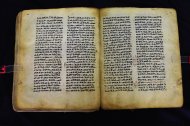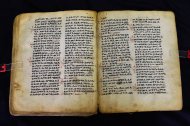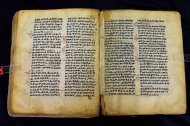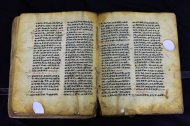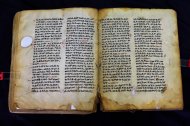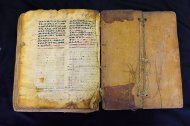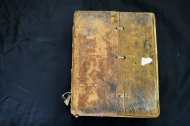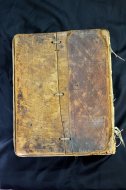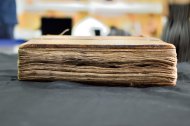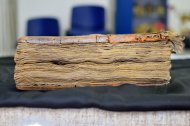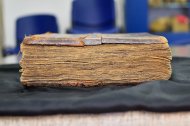|
Shelfmark |
191 |
|
Owning institution |
Museo Archeologico e d’Arte della Maremma – Museo d’Arte Sacra della Diocesi, Grosseto |
|
Typology |
Codex |
|
Copying date |
Late 14th – early 15th century, dated on a paleographical basis. |
|
Title |
Arbaʿǝttu wängelat (Four gospels) |
|
Subject |
New Testament, Bible |
|
Language |
Gǝʿǝz |
|
Short description of the content |
Ff. 1ra–9vb: Mäqdǝmä wängel (“Introduction to the Gospel”, in seven chapters); Incipit: በስመ፡ … ንቅድም፡ በረድኤተ፡ እግዚኣብሔር፡ ይትባረክ፡ ስሙ። ወይትሌዓል፡ ዝክሩ። ዘእምኔሁ፡ ኵሉ፡ ሢመተ፡ ኃይል፡ ወቦቱ፡ ተፍ[.]ሜተ፡ ኵሉ፡ ስእለት፡ ወኃቤሁ፡ ምብጻሐ፡ ኵሉ፡ አስተብቍዖት። Ff. 9vb–10va: Gǝṣṣawe śǝrʿat (“Synopsis of Classes”); Incipit: በእንተ፡ ኅብረተ፡ ቃላት፡ ዘአርባዕቱ፡ ወንጌላት፡ ግጻዌ፡ ሥርዐት፡ እንዘ፤ ይተሉ፡ ረድኤተ፡ ክልኤቱ፡ ባሕቲቶሙ፡ ጸሐፉ፡ እንከ፡ ወንጌለ፡ እምሐዋርያት፡ ወክልኤቱ፡ እመትሎሆሙ። አሐዱ፡ ዘጰውሎስ፡ ወአሓዱ፡ ዘጴጥሮስ፡ ረድአ፡ ዚኣሁ። Ff. 10va–11vb: Letter of Eusebius to Carpianus; Incipit: አውሴብስ፡ ለቀርጲያኖስ፡ ለዘአፈቅር፡ እኁየ፡ ፍሥሓ፡ ወዳኅና፡ ለከ፡ እምኀበ፡ እግዚአብሔር፡ አሞንስ፡ እንከ፡ አለክስንድራዊ፡ በብዙኅ፡ አስተሐምሞ፡ ወጽሂቅ፡ ገብሩ። ወኀደገ፡ ለነ፡ ቃለ፡ ዘከመ፡ ኀብሩ፡ አርባዕቱ፡ ወንጌል። ወእምዝሰ፡ አርእስተ፡ ምንባባት። Ff. 12r–15r: Śərʿatä qämär zäkämä ḫabru arbaʿǝttu (Canon tables); Ff. 15v–66rb: Wängel zäMatewos (“Gospel of Matthew”)
Incipit: መጽሐፈ፡ ልደቱ፡ ለእግዚእነ፡ ኢየሱስ፡ ክርስቶስ፡ ወልደ፡ ዳዊት። ወልደ፡ አብርሃም፡ አብርሃምኒ፡ ወለደ፡ ይስሐቅሃ። ወይስሐቅኒ፡ ወለደ፡ ያዕቆብሃ፡ ወያዕቆብኒ፡ ወለደ፡ ይሁዳሃ፡ ወአኃዊሁ፡ ወይሁዳኒ፡ ወልወደ፡ ፋሬስሃ፡ ወዛራ፡ እምነ<፡> ትዕማር።
Ff. 66v–95rb: Wängel zäMarqos (“Gospel of Mark”)
Incipit: ቀዳሚሁ፡ ለወንጌል፡ ኢየሱስ፡ ክርስቶስ፡ ወልደ፡ እግዚአብሔር። በከመ፡ ጽሑፍ፡ ውስተ፡ መጽሐፈ፡ ነቢያት፡ ናሁ፡ አነ፡ እፌኑ፡ መልአክየ፡ ቅድመ፡ ግጽከ፡ ዘይጸይሕ፡ ፍኖትከ፡ በቅድሜከ። ቃለ፡ አዋዲ፡ ዘይሰብክ፡ በገዳም፡ ወይብል። ጺሑኣ፡ ፍኖቶ፡ ለእግዚኣብሔር፡ ወዐርዩ፡ መጽያሕቶ። =።
Ff. 95v–140vbb: Wängel zäLuqas (“Gospel of Luke”)
Incipit: እስመ፡ ብዙኃን፡ እለ፡ አኀዙ፡ ይወጥን፡ ይግበሩ፡ ወይንግሩ፡ ወይምህሩ፡ ነገረ፡ ዘንሕነ፡ ጠየሕነ፡ በእንተ፡ ግብር፡ ዘአምኑ፡ በላዕሌነ። በከመ፡ መሀሩነ፡ እለ፡ ቀደሙነ፡ ርእዮቶ። ወተልእክዎ፡ በቃሉ። ወኮነ፡ እምቅድመ፡ ይርአዩ፡ ኵሎ፡ ዘኮነ፡ ወይትለአኩ፡ ለቃለ፡ ፈቃዱ።
Ff. 141r–179vb: Wängel zäYoḥannəs (“Gospel of John”)
Incipit: ቀዳሚሁ፡ ቃል፡ ውእቱ። ወውእቱ፡ ቃል፡ ኀበ፡ እግዚኣብሔር፡ ውእቱ፡ ወእግዚኣ<ብ>ሔር፡ ውእቱ፡ ቃል። ወከማሁ፡ ቀዳሚሁ፡ እምቀዲሙ፡ ኀበ፡ እግዚኣብሔር፡ ውእቱ። =። ወኵሉ፡ እንከ፡ ቦቱ፡ ኮነ። ወዘእንበሌሁሰ፡ አልቦ፡ ዘኮነ፡ ወኢምንተኒ። ወዘሂ፡ ኮነ፡ በእንቲአሁ፡ ቦቱ፡ ሕይወት፡ ውእቱ።
|
|
Writing material |
Goat parchment |
|
Outer size (included the binding) |
340 x 260 x 100 mm |
|
Outer size of the textblock |
340 x 260 x 95 mm |
|
Number of folia |
179 |
|
Blank folia |
1r–2v, 149rb–162v. |
|
Binding |
Two wooden boards covered with reddish-brown leather for the inner half along the vertical axis. Both covers are decorated on the outer side with blind tooled ornaments in the shape of lines and circles. Four sewing stations. Presence of a dark blue cotton bookmark, sewn in the outer upper margin of f. 145. |
|
Sewing |
Two Z-twisted threads (each thread is S-twisted) of animal origin. |
|
Sewing pattern |
Bozzacchi A4 |
|
Slip case |
Leather case; 420 x 270 mm. |
|
Quires |
23 |
|
Quire marks |
– |
|
Layout |
1 column (ff. 15v–16v, 66v–67r, 95v, 96rv, 141rv) 2 columns (remaining folia). |
|
Number of lines per column |
29–30 (text of the gospels), 28–41 (tituli), 46 (tables of the canons) |
|
Ruling |
Blind ruling, from outside to inside. Lines are generally written above the ruling, occasionally under the ruling (e.g. ff. 74v, 87v) |
|
Ruling pattern |
Intermediate position between patterns Nosnitsin 1 and Nosnitsin 2. |
|
Scribe |
Unknown |
|
Colophon |
– |
|
Additional notes |
1. Ff. 1va–2rb: Miracle of Mary: Mary offers up water to a thirsty dog. Incipit: ተአምሪሃ፡ ለእግዝእትነ፡ ቅድስት፡ ማርያም፡ ድንግል፡ በክልኤ፡ ወላዲተ፡ አምላክ፡ ጸሎታ፡ ወበረከታ፡ ወምሕ<ረ>ታ፡ ፍቁር፡ ወልዳ፡ የሀሉ፡ ምስለ፡ ገብር፡ […] ሰላም፡ አሜን፡ ወሐለዋ፡ አንስት፡ ምስለ፡ እግዚእት፡ (sic) ቅድስት፡ ማርያም፡ ድንግል፡ በክልኤ፡ ወላዲተ፡ አምላክ፡ ወመጽአ፡ ሃቤሆን፡ ከልብ፡ ጽመአ፡ (scil. ጽሙአ፡), “Miracles of our Lady Holy Mary, two-fold virgin, mother of God. May her prayer, her blessing, and her mercy be upon her beloved son with the servant […], peace, amen. There were some women with our Lady Holy Mary, two-fold virgin, the mother of God, and a thirsty dog came to them”. The text is written in an untrained hand. It begins on the outer margin of f. 2rb and continues on the lower margin of ff. 2ra, 1va, and 1vb. The name of the supplicant has been erased. 2. F. 3r: unidentified note, written in black ink in an inaccurate hand. Text: ሰዐወ፡ ሃበኪ፡ ዘ፡ እብራዊ፡ ለድምያኖስ፡ አመተ፡ ይስሃቅ፡ ዘአትሎኪያ፡ ምስለ[፡] አራቱ፡ ዘእጽ፡ ጌ፡ አፀደ፡ ወይን፡ማርያም፡ ዘካርያስ፡ ሐይልኪ፡ ማርያም፡ ስነ፡ አሪባዋያን፡ ሃይለኪ፡ ተወኪፍኪ፡. 3. Ff. 11va–b: elaborate protective prayer, written in an inaccurate hand by a certain Särṣä Dǝngǝl. The text contains several citations from psalms and other non-biblical sources. Incipit: [..]እግዚኦ፡ መኑ፡ ከማከ፡ (cp. Ps 34.11) እስከ፡ ሳበ፡ (sic) ይብል፡ ምባእ፡ ውስተ፡ ገጾሙ፡ ኅሳረ፡ አቶ<፡> ዮናውል፡ ድልቅስም፡ አዶናይ፡ ይርከትዮን፡ ይንጥርስ፡ አንስእ፡ ኃይልከ፡ ወነአ፡ አድሕነነ<፡> (cp. Ps 79:3) እስመ፡ ሃብአኒ፡ ውስተ፡ ጽላሎቲ፡ በዕለተ፡ ምንዳቤ፡ ወሰወርኒ፡ በእንተ፡ በምሕባአ፡ ጽላሎቱ፡ (cp. Ps 26:9). 4. F. 12vb: note written by the same hand of the previous text, of which this is probably the continuation. 5. F. 15r: Mälkǝʾ-hymn to Mary, probably written in the same hand as texts 3 and 4. Incipit: ይቤላ፡ መልአክ፡ ሰላም፡ ለኪ፡ ይቤላ፡ ገብርኤል፡ ሰላም፡ ለኪ። ማርያም፡ ድንግል፡ ሰላም፡ ለኪ፡ ወላዲተ፡ አምላክ፡ “The angel told her: ‘Salutation to you’. Gabriel told her: ‘Salutation to you, Virgin Mary, salutation to you, mother of God’”. 6. F. 16va: synopsis of the passion of Jesus Christ on Good Friday. The text is written in an ancient hand, probably contemporary to that of the main text. Elements of the interpunction and of the numerals are rubricated. Incipit: በዓርብ፡ ዕለት፡ ሶበ፡ ይጸብሕ፡ ምድረ፡ ዕዝል፡ በል፡ በልዑ፡ ቃል፡ ሃሌ፡ ሃሌ፡ ሉያ። በጽባሕ፡ ተመከሩ፡ ሊቀነ፡ (sic) ካህናት፡ ይስቅልዎ፡ ለኢየሱስ።. |
|
Decoration |
F. 1r: polychrome ornamental band (ḥaräg). The band, extended above both columns, occupies approximately the lower half of the upper margin of the folio and is decorated at the corners with stylized palmettes. Ff. 17r, 68r, 98r, 142r: polychrome ornamental frames (ḥaräg) decorated with interweaving motifs. F. 67v: polychrome full-page portrait of St Mark. Caption in the upper margin: ሥዕለ፡ ቅዱስ፡ ማርቆስ፡ ወንጌላዊ። “image of St Mark the evangelist”. F. 97v: polychrome full-page portrait of the St Luke. Caption in the upper margin: ሥዕለ፡ ቅዱስ፡ ሉቃስ፡ ወንጌላዊ። “image of St Luke the evangelist”. |
|
State of preservation of the binding |
Discrete |
|
State of preservation of the textblock |
Mediocre. |
|
Provenance and history |
The manuscript came into the possession of an unknown Italian soldier during the military aggression of 1935–36, from an unknown church, perhaps in conjunction with the invasion of Təgray. After the war, it remained in the hands of the soldier, in Grosseto, until it was donated to the local Bishopric as a gift, and later entrusted to the Museo Archeologico e d’Arte della Maremma (MAAM) in permanent deposit. |


